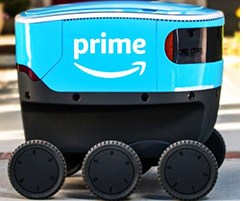Delivery Robots Nudging in on Sidewalk Traffic
A growing fleet of tiny, last-mile delivery robots are beginning to hit the sidewalks in Beijing, London, Seattle and other busy international cities, Scientific American reports.
A growing fleet of tiny, last-mile delivery robots are beginning to hit the sidewalks in Beijing, London, Seattle and other busy international cities, Scientific American reports.

Starship Technologies, a San Francisco-based startup says, its $5,500 robots have made more than 25,000 deliveries in various pilot programs in recent years. Online retail giant Amazon Inc. is launching tests this year near Seattle with its Scout device, a robotic six-wheeled unit (left) about the size of a portable ice chest cooler.
Citing a recent McKinsey & Co. study, Scientific American notes that autonomous robots can cut delivery costs by as much as 40% over typical delivery vans. They also help reduce street congestion and avoid the potential of double-parked vehicles blocking crosswalks, fire hydrants and bike lanes.
But there also are several challenges, including the potential of a package being stolen and pedestrians otherwise interfering with or damaging a robot. In addition, the automated devices must be able to traverse uneven sidewalks, avoid myriad obstacles and do so without disrupting pedestrians and bicyclists. This can be extremely difficult in busy downtown areas, analysts say, noting that San Francisco temporarily banned sidewalk robots in 2017.
Other delivery alternatives also are starting to emerge, such as Nuro Inc.’s street-legal autonomous pod. About half the width of a compact crossover vehicle, the pod is being used by Kroger to deliver groceries in a test program in Scottsdale, Ariz.
Increased competition is likely with retail deliveries growing by 16% in the U.S. during 2017. But with the high initial costs of a delivery bot, old fashioned bicycles remain one of the most effective ways to make last-mile deliveries, a previous McKinsey study points out.
RELATED CONTENT
-
Simplifying Machine Load/Unload Automation
Today, lower part volumes and frequent change-over are changing the offerings of some automation integrators. Standard, off-the-shelf components are being engineered to work together in a large variety of applications and, in some cases, are even portable so they can be moved from machine tool to machine tool.
-
Making Waves with Lathe Automation
After years of relying on an extensive machining cell for part production, this marine equipment manufacturer has now reduced part handling and improved quality through use of single-setup lathes and automated loading and unloading.
-
Bar Feeder Basics
Some primary factors are often overlooked when considering how to justify the implementation of a bar feeder for turning operations.


